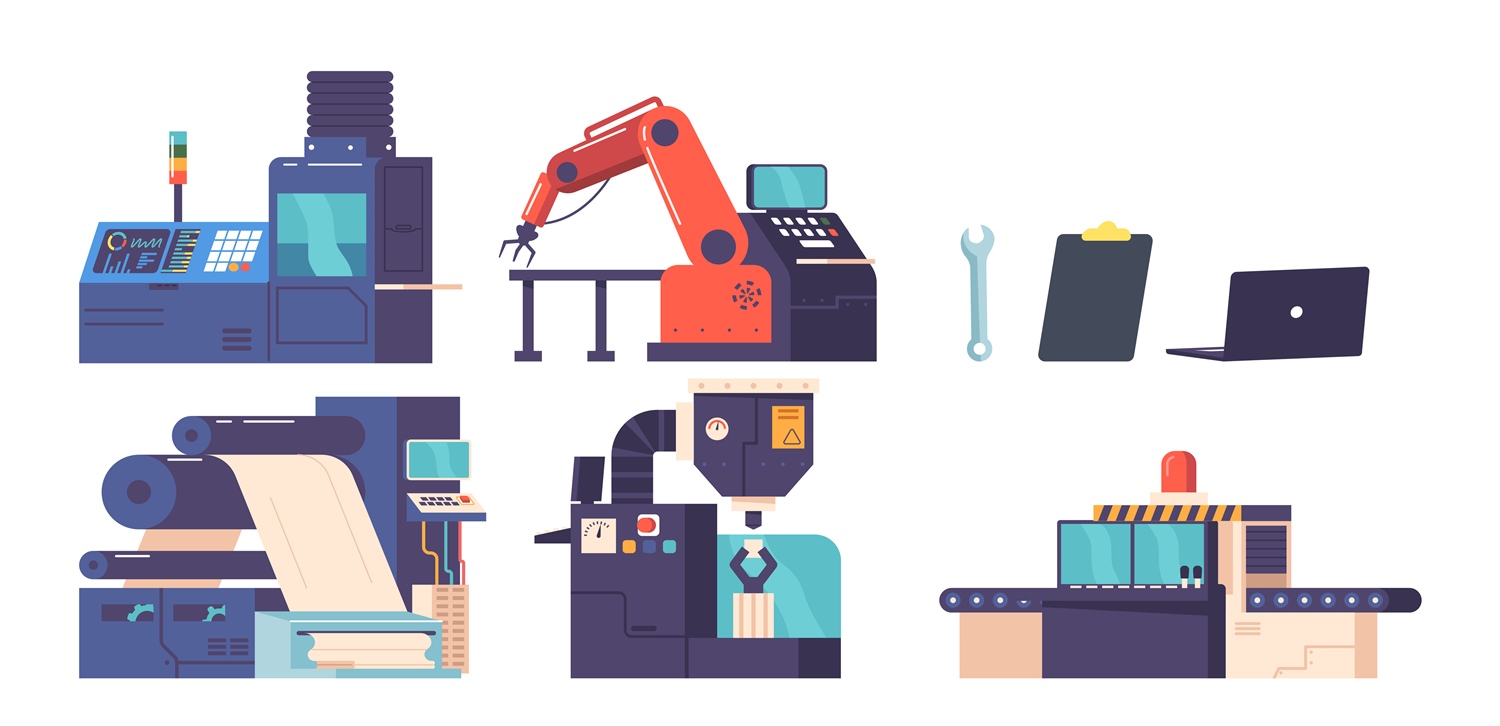P3 7-8/2023 en
Business Reengineering
Game Changer in Organizational Development
Management & Marketing

In rationalization projects, people are often overlooked as a success factor in operational activities.
Manufacturing companies often try to solve profitability and cost problems by using new technologies. However, they rarely question their organizational structures. But this is also necessary in order to achieve quantum leaps in key figures such as resource consumption, throughput and delivery times.
In rationalization projects, people are often overlooked as a success factor in operational activities.
A radical change is taking place in the manufacturing industry. Due to intensifying competition, (inter)national overcapacity, rising wage and energy costs, etc., there is a noticeable effort on all sides to make corporate structures lean and cost-effective and therefore competitive with the help of digital technology, among other things.
Many management concepts promise help here. Examples include Lean Management/Production, Total Quality Management and Kaizen. Another approach that boomed around the turn of the millennium is so-called business reengineering. This concept is still used in many restructuring projects today because it combines the effort to design operational processes more intelligently with the demand for customer-oriented production.
View the business processes holistically
The strong response this concept receives is also explained by the fact that many rationalization projects and cost reduction measures in the past led to a dead end. They have reduced personnel costs so much that they now often account for less than ten percent of the total costs of industrial production. However, people are often overlooked as a success factor in operational activities.
Business reengineering takes a different approach to reorganizing operational processes. It builds on the successful concepts of the past decades, which are linked to the concept of lean production and also rehabilitated people as an important productivity factor. However, business reengineering wants more. It promises growth on a scale no longer considered possible; also an increase in operational prosperity despite increasing competition. The approach for this lies in a holistic view of company processes that combines the three dimensions of process, employee and customer orientation.
This is what distinguishes business reengineering from previous optimization approaches. These often only sought improvements in one of the three dimensions mentioned. Business reengineering, on the other hand, aims to reorganize all areas of action and processes relevant to success in a company. It also aims to radically streamline its core business processes with the aim of:
- to increase customer benefit and
- to further develop the organization in such a way that long-term competitive advantages are created.
In order to achieve this, business reengineering fundamentally questions existing corporate practices. It examines them critically and reorganizes them along the operational value chain.
Identify the causes of problems in the organization
Such a radical cure requires the willingness to fundamentally rethink and reshape all business processes. Only then can the ambitious goal of drastically improving performance data such as costs, quality, service and speed be achieved. These changes will only have a lasting impact if, at the same time, the human production factor becomes the focus of strategic considerations again.
This is not yet the case for many production companies. Traditionally, they respond to profitability and cost problems
- a volume growth,
- an increase in the level of refinement,
- the use of improved technologies, processes and recipes as well
- an optimization of the use of raw materials.
Overall, there is a focus on technological improvements. Although unsatisfactory processes are occasionally replaced by more efficient ones and more sophisticated budgeting and controlling procedures are implemented, the question of the causes of the problems in the operational organization is rarely asked. Rather, we are looking for potential for improvement while maintaining the rigid organizational structures.
Overcoming the barriers to innovation
That is why the organizational structures of many manufacturing companies currently largely contradict the characteristics of modern corporate management and design. For example, until recently, the mostly Tayloristic work structures and processes were not yet available in many companies. Likewise, approaches aimed at consistently using the innovative strength of employees were not pursued. These were primarily seen as a cost factor. This is demonstrated by the various efforts to reduce personnel costs.
A strongly hierarchical and functionally oriented organizational structure still dominates in production companies. The companies are almost entirely structured according to the technical systems. The way employees think corresponds to the Tayloristic-functional work organization. They are often machine specialists stuck in departmental thinking. The disadvantages of such rigid organizational forms and thought structures become particularly evident in economically difficult situations such as the current one. Then they turn out to be barriers that hinder fundamental solutions to problems. Such problems include, among others
- long judicial processes,
- a variety of competence demarcations,
- one-sided qualification of employees,
- a lack of motivation and lack of identification of employees with the company as well
- a superficial fixation on the cost structure.
In addition, the form of organization characterized by Taylorism led to a narrowing of thinking to machine activities, particularly in manufacturing. There is no space in it for an idea of the process flow of production. This severely limits the interchangeability of personnel; In addition, due to their limited scope for action, employees hardly develop any form of thinking.
Where capital-intensive large-scale systems shape cost accounting, the employees at the center of the action are generally rarely considered. The neglect of the human factor is justified by the fact that it plays only a minor role in the operational cost structure. After all, the share of personnel costs in the total costs in many industrial companies is only 8 to 15 percent. Therefore, no potential for radical rationalization successes is seen here. What is overlooked is that the entire process is controlled with these 8 to 15 percent of the costs, i.e. the multiple of other costs is influenced.
Use the success potential of “human employees”
Therefore, an elementary management task is to fully utilize the performance and innovation potential of employees. Business reengineering considers cross-functional and cross-departmental teamwork to be the best way to achieve this; be it in the form of temporary teams (e.g. project groups, CIP groups) or in the form of permanently collaborating working groups (group work). The decisive advantage of such an organization lies in the synergy effects achieved. They can be described with the mathematically impossible formula 2 + 2 = 7. It says that a team that works effectively together achieves more than the sum of the individual team members.
The promotion of teamwork as a basic work organization model is strongly reminiscent of the ideas of lean management or lean production. But business reengineering goes one step further by rearranging all business processes; for example, to make the process as lean and cost-effective as possible. The teams are tasked with continually improving the performance standards already achieved through reengineering.
This approach coincides with megatrends in modern corporate management. Especially in industries that are confronted with revolutionary technological innovations and a relatively unstable environment (markets, material prices), modern management not only has to constantly redefine the importance of the techniques and technologies to be used. It must also create an organizational form that allows for maximum flexibility and efficiency in the use of all resources. Consequently, management must also deal intensively with the topics of work organization, leadership and personnel development and thus with the human factor for success.
Rethink work organization, leadership and personnel development
The following lines of development can be observed with regard to future-oriented corporate management, and not only in the manufacturing industry.
Leadership: (Top) management must devote more time to strategic challenges and spend less time in day-to-day operational business. In order to carry out its creative tasks (such as opening up new business areas), it needs sufficient freedom. That's why managers have to delegate as much as possible the various routine tasks that they are still busy with today.
Decision/Control: Modern management delegates decision-making authority from top to bottom. This relieves the burden on middle and upper management. External control becomes ongoing self-control and organization below operational management. This creates the necessary freedom that managers need, among other things, to shape the future.
Organization: By combining previously separate functions, holistic tasks are created that employees or teams carry out independently. This makes it clear to employees how important their work is for the company. This increases their sense of responsibility and their identification with their own actions. It also promotes the “we” feeling.
Products: The increased competitive situation requires high quality products and services; on the one hand, to ensure optimal customer satisfaction, and on the other hand, to avoid waste. For example, by reducing rejects, costs can be reduced and discounts due to poor quality can be avoided. This increases profitability and improves operating results and competitiveness.
Strategy: Concentrating the company's activities on the core business and core competence (using strengths, expanding profitable business areas) also contributes to improving the operating result. An increase in added value is also achieved through the expansion of core competence and targeted outsourcing of unprofitable business areas.
Build and design the organization in a process-oriented manner
Where the outlined development lines of a modern management and leadership style take effect, a process-oriented structure and process organization replaces the traditional forms of corporate organization. The focus of the company organization is on efforts aimed at:
- to speed up order processing,
- eliminate interfaces of business processes as possible sources of error and
- initiate measures to improve results.
At the same time, all forms of centralized planning and control practiced from above fade into the background. Fitness programs and reorganization projects based on this aim to make better use of the potential on the shop floor level or on site by relying on decentralization; also on the competence, personal responsibility and self-organization ability of the employees.
Achieving such goals is only possible with creative, adaptive, committed and proactive employees. It is therefore a central management task to create the conditions so that employees can fully develop their potential. This is best achieved by introducing a team-oriented work organization.
Realign the company, thinking and doing
Such far-reaching interventions in existing structures as those carried out by business reeignineering do not always occur without conflict. Problems arise especially in companies (areas) that have little experience with teamwork. If the reorganization also enables extensive job cuts, which are sometimes necessary to operate profitably, then it often proves difficult to achieve sufficient acceptance of the change measures among the workforce.
It is an advantage if the company already has experience with total quality management (TQM), the continuous improvement process (CIP) or lean management. Because TQM and CIP, as well as working in groups and teams, educate employees to think cross-functionally. That's why companies that have already gone through corresponding change projects are usually more mature than others. This means that they can more easily absorb and implement the reengineering philosophy because business reengineering includes elements from all of these approaches.
Dr. Georg Kraus is managing partner of the management consultancy Kraus & Partner, Bruchsal. He is, among others, a lecturer at the University of Karlsruhe, the IAE in Aix-en-Provence, the St. Gallen Business School and the Clausthal University of Technology.







